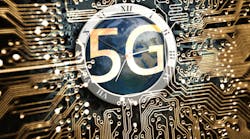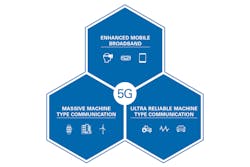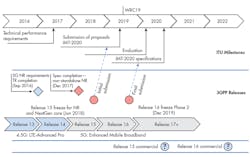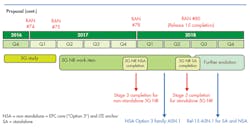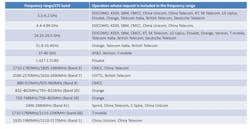Download this article in PDF format.
It’s all about 5G. No matter where you go or who you’re talking to, 5G is at the center of conversations about exciting new technology. While recent announcements from Mobile World Congress indicate that 5G is already here, it’s not. But we’re getting very close.
The wireless communications community has had a busy year. From progress made on the standardization process and essential updates communicated from regulatory bodies, to gaining understanding of the channel for newly proposed millimeter-wave (mmWave) frequencies and technologies under development that will turn 5G into a commercial reality, anticipation for 5G is at an all-time high. So, what do all of the accomplishments from the past year mean for 5G? And when will 5G be here?
5G Frequencies: A Combination of mmWave and Sub-6-GHz
There’s a lot left to be defined when it comes to 5G, but one thing is certain: Sub-6 GHz spectrum is still very important, and mmWave frequencies will be used to supplement sub-6 GHz technology.
Figure 1 shows the wide range of requirements expected of 5G, from ultra-reliable, high-bandwidth communication for enhanced mobile broadband (eMBB) applications, to the low-bandwidth, machine-to-machine (M2M) type communications we expect to see in Internet of Things (IoT) applications.
1. Targeted 5G applications include enhanced mobile broadband and machine-to-machine communication.
It’s difficult, if not impossible, for one band of spectrum to meet these needs. However, combining two bands provides complementary coverage. Sub-6-GHz spectrum offers better propagation and backward compatibility for narrowband applications, while the contiguous bandwidth at mmWave frequencies enables the key eMBB applications promised by 5G.
The Timeline
The International Telecommunications Union (ITU) has defined two phases of research (Fig. 2): Phase 1 for sub-40-GHz and Phase 2 for sub-100-GHz. Phase 1 is scheduled to end in June 2018 to correspond with the 3GPP’s LTE release 15. Phase 2 is slated to end in December 2019 to correspond with LTE release 16. Fig. 2 shows both the ITU and 3GPP timelines as of Fall 2016.
2. Shown are the ITU and 3GPP timelines for 5G.
The ITU’s proposed dates and the frequencies that will be used are anything but certain, though. At the March 2017 3GPP RAN plenary meeting (#75), a way forward (WF) was presented with an accelerated schedule for the release of 5G New Radio (NR) (Fig. 3).
3. This is the accelerated 3GPP NR release schedule as of March 2017.
NTT DOCOMO presented its recommendation for which frequency bands should be used during the last RAN4 meeting (#82) in a Way Forward (WF). The table summarizes the frequency ranges and corresponding telecom operators.
The above table shows the proposed NR spectrum way forward from the RAN4 Meeting #82, which was recommeded to the RAN Plenary #75.
28 GHz and Verizon
The work at 28 GHz has dominated the news on sub-40-GHz research over the past year, but it’s not the only frequency under consideration. The FCC and Verizon have been driving the work at 28 GHz. To allocate additional mmWave bands for flexible use and future proposed rulemaking, the FCC approved the Spectrum Frontiers Proposal in July 2016. The 28-GHz band is one of the three bands available today for flexible use in the United States.1 Figure 4 presents a visual of the bands.
Based on the WF at the RAN4 meeting, global carriers, including European operators Orange, British Telecom, and Telecom Italia, have established significant alignment around 24-28 GHz. This may seem surprising based on previous conclusions that 28 GHz isn’t a suitable band for Europe because of frequency incumbents, but the lower frequencies in that band have potential. As expected, those same European operators are requesting spectrum at 32 GHz.
Verizon secured a license for the 28-GHz band from XO Communications last year, and has been vocal about its desire to use this frequency for its initial deployment. Despite not having a fully standardized version of the technology to roll out for this testing, Verizon is making a bet that the hardware they deploy now will have the capability to run whatever specification is eventually released through a software update in the future.2 Other U.S. carriers have agreed to use the 28-GHz band, and both AT&T and T-Mobile indicated that they will conduct more research on 28-GHz-based technologies and partner with equipment providers for additional field trials.
4. Seen here are mmWave bands allocated by the FCC.
In 2015, Verizon established the 5G Technical Forum (5GTF) with Cisco, Ericsson, Intel, LG, Nokia, Qualcomm, and Samsung. The working group’s main goal was to develop a wireless alternative to fiber to the home (FTTH) using mmWave spectrum, also known as Fixed Wireless Access (FWA). The 5GTF draws largely from the LTE standard and adds concepts now being researched and proposed for 5G in 3GPP.
The 5GTF extends the subcarrier spacing by a multiple of 5 (75-kHz subcarriers versus 15 kHz yielding 100-MHz bandwidth per component carrier) and reduces the subframe spacing by an inverse proportion to maintain timing consistency with LTE. The 5GTF also added control signals and expanded the physical layer to include digital beamforming and precoding.
At the IEEE Wireless Communications and Networking Conference (WCNC) in San Francisco, National Instruments (NI) demonstrated a real-time working prototype of the 5GTF. While not the first prototype of the specification, it was notable for several reasons, one of which being that it was the first public demonstration of the technology in action.
Verizon is aware that it will push out mmWave technology pre-standardization. The question looming over V5G is whether it will comply with 3GPP 5G standards or not; hence, the risk of deploying mmWave technology before defining the standards. If Verizon’s gamble pays off, Verizon will have a significant head start in the race to 5G. If not, it will need to replace a lot of outdated hardware.
New Radio (NR)
NR is intended to cover all applications and all frequency bands, including the three main application performance indicators for 5G put forth by the ITU: enhanced mobile broadband (eMBB), Ultra Reliable Low Latency Communications (URLLC), and Massive Machine Type Communications (MMTC). That means that the physical layer needs to be flexible enough to generate significantly higher data throughput while allowing for hundreds of times more devices to connect to the network for Narrowband IoT (NB-IoT).
The PHY also needs to be reliable enough with low enough latency to be used in self-driving cars. This is no easy task, and the standards being proposed for NR are significantly more complex than V5G. Certain aspects like adding beam management are similar between the two, but NR will incorporate both slow and fast beam management. NR will also leverage LTE as much as possible, but it uses different sample and subcarrier rates.
Despite the buzz around NR and a desire to finalize the standard earlier than initially planned, not much data has been published about the performance of the specification. The limited trials at 28 GHz have focused more on channel sounding than demonstrating the feasibility of the NR specification. NI has developed a New Radio prototyping system that can run a multi-user MIMO link. This system uses the NI mmWave Transceiver System (MTS) and flexible physical-layer IP written in LabVIEW.
A 2018 Finish Line for the Race to 5G
By early 2018, we will likely have an answer to “What is 5G?” Based on the accelerated schedule presented at the March 2017 3GPP RAN plenary meeting (#75), the physical layer and MAC layer for NR will be settled by the end of 2017.
Frequency selection doesn’t have a strict deadline, but operators are pushing technology forward to get 28-GHz hardware deployed in 2017 field trials. By the second quarter of 2018, South Korea will have demonstrated its 5G technology preview. The full standardization process will not be complete yet, but a clearer picture of what 5G is will begin to emerge. The race to define 5G may be ending, but the process to design and deploy 5G technology is just beginning.
References
1. Use of Spectrum Bands Above 24 GHz for Mobile Radio Services, GN Docket No. 14-177, Notice of Proposed Rulemaking, 15 FCC Record 138A1 (rel. Oct. 23, 2015).
2. http://www.fiercewireless.com/tech/verizon-files-to-conduct-28-ghz-market-trials-4-states.
